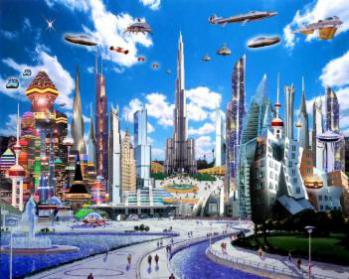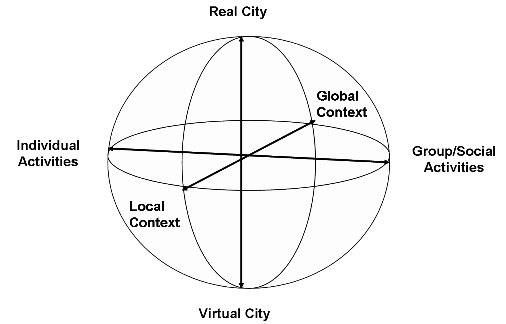Moving beyond 'Smart-only' Cities towards Humane, Sociable, and Cooperative Cities by Rethinking Cities as Self-aware and Hybrid Cities
There are many visions about the City of the Future, sometimes colorful illustrated as in the pictures shown below. But do they communicate what we are actually looking for?
What we need is a vision that reconciles humans and technology and, of course, also ecology. (the latter is very important but is not the focus of the research carried
out in this context.)
In short, we argue for a city where people enjoy everyday life and work,have multiple opportunities to exploit their human potential and lead a creative life.
We call it “The Humane City”.
The issues we are concerned with now are (besides the economic, political and social issues)
- How can information technology support people in such a humane city?
- what are the appropriate design goals and how can we realize them?
The application of information technology in the context of future cities is often indicated by notions of Smart Cities or Ubiquitous Cities (u-cities). They are defining a new area for the application of concepts and developments in Ambient Intelligence and Ubiquitous Computing. In a way, it is a natural consequence of extending the scope of work on smart rooms and smart and cooperative buildings to the next level addressing, e.g., public spaces but, in the end, covering comprehensively all activities related to living and working in an urban environment.
The complementation of a "traditional" real city with an additional digital city layer results in what we call a "hybrid city". The transition and transformation of a traditional city into a "smart, but cooperative city" and its goal-orientation to act and present itself as a "humane, self-aware, sociable and cooperative" city is illustrated in the figure below.
For more details of our approach of Moving Beyond 'Smart-Only' Cities in the context of Redefining the 'Smart-Everything' Paradigm, see the papers cited below (Streitz, 2019, Streitz 2021).
A very interesting special case of an urban environment is an "airport" and the way to transfrom airports into "smart airports" because they show most of the relevant basic issues in a very concentrated and focussed manner.
But there is more to it. It reflects the motivation of contributing to finding solutions to the problems we are confronted with in a new era we are living in, called the Urban Age. Already by the end
of 2008, half of the world population lived in urban areas and this trend will continue. By 2050, 70 % of the world population will live in cities.
Along this line of argumentation, Urban Life Management was proposed as an umbrella scenario that helps to formulate appropriate research lines in the context of writing the "white paper" (already in
2009) on identifying deficits and future research agendas in these areas. As part of this work, the concept of a Hybrid City was proposed by Norbert Streitz. A Hybrid City consists of a real city
with its physical entities and real inhabitants and a parallel virtual city of counterparts of real entities and people. Nevertheless, there will be no complete match between real and virtual
entities. Thus, we can state that there will be a continuous dimension with “real” and virtual” as its end points as indicated in figure 1 below. The other two dimensions that we find useful are the
distinction between “local context” and “global context”, on the one hand, and between “individual activities” and “group/social activities” on the other hand.
Fig. 1 Key Dimensions of Humane, Hybrid Cities (there are more but not depicted here)
These three dimensions are in a next step then combined with the property of "smartness" which can be present at different levels resulting in the notion of a Smart City.
The following issues were raised in the first version of the "white paper":
- “How can the realization of a smart hybrid city contribute to reducing and potentially even avoiding some of the problems that are faced by today’s cities and in the future?”
or in other words
- “How can ambient and ubiquitous ICT help to contribute to Urban Life Management?
This can be analyzed and has to be investigated from the following two perspectives:
- How to manage a person’s / a group’s life in today’s and future cities?
- How to manage the urban environment of today’s and future cities?
While formulating it as two perspectives, it should be clear that they are not independent; but it helps also to identify the different user needs depending on who are the users:
- People living and working in the city; searching, checking, evaluating and then utilizing the services that are offered by the urban environment with respect to the different aspects of life
- People who are organizing and administering the urban infrastructure so that the services are available for citizens and visitors.
Examples of how the smart or hybrid city of the future could operate are: taking care of its individual inhabitants by offering personalized services (e.g. for
leisure, shopping, administration but also for security and health), providing optimized opportunities of transportation by combining various sources of traffic information at the same time and
integrating different means of transportation, providing opportunities for the involvement of people in the community, e.g., by matching people on the basis of common interests and suggesting common
activities or in other words: offering multiple opportunities for social engagement in order to be an active part of society.
References
Norbert Streitz (2021). From Smart-Only Cities towards Humane and
Cooperative Hybrid Cities. Technology | Architecture + Design. Volume 5, Issue 2.
pp. 127 - 133. (Taylor & Francis). DOI: 10.1080/24751448.2021.1967050
Norbert Streitz (2019). Beyond 'Smart-Only' Cities: Redefining the 'Smart-Everything' Paradigm. Journal of Ambient Intelligence and Humanized Computing. vol. 10, no. 2, pp. 791-812. (Springer). First online: 31. May 2018.
DOI: 10.1007/s12652-018-0824-1
Norbert Streitz, Dimitris Charitos, Maurits Kaptein, Marc Böhlen (2019).
Grand Challenges for Ambient Intelligence
and Implications for Design Contexts and Smart Societies. Tenth Anniversary Issue, Journal of Ambient Intelligence and Smart
Environments. vol. 11, no. 1, pp. 87 - 107. (IOS Press).
DOI: 10.3233/AIS-180507
Norbert Streitz (2017). Reconciling Humans and Technology: The Role of Ambient Intelligence. Keynote Paper. In: A. Braun, R. Wichert, A. Mana (Eds.),
Proceedings of the 2017 European Conference on Ambient Intelligence.
Lecture Notes in Computer Science (LNCS 10217), Springer-Verlag. (pp. 1-16).
Norbert Streitz (2016). Opportunities and Risks of Digitalization in the Context of Smart Hybrid Cities and Airports. In: Proceedings of USEWARE 2016 -
Mensch-Technik-Interaktion im Industrie 4.0 Zeitalter. 8. VDI-VDE Fachtagung. VDI-Berichte 2271. VDI Wissensforum. VDI-Verlag (pp. 5 - 14).
Norbert Streitz (2016). Smart Cities Need Privacy by Design for Being Humane.
In: Susa Pop, Tanya Toft, Nerea Calvillo, Mark Wright (Eds.),
What Urban Media Art Can Do - Why When Where and How ?
avedition (pp. 268 - 274).
Norbert Streitz (2015). Citizen-Centered Design for Humane and Sociable Hybrid Cities. (Keynote). In: I. Theona & D. Charitos (Eds.),
Hybrid City 2015 - Data to the People. Proc. of the Third International Biannual
Conference. University of Athens, Greece. (pp. 17-20).
Norbert Streitz (2012). Designing Smart Cities: Urbane Räume als Orte
vernetzter Arbeits- und Lebenswelten. In: Reiterer, H. & Deussen, O. (Hrsg.), Mensch & Computer 2012: interaktiv informiert – allgegenwärtig und
allumfassend!?. München: Oldenbourg Verlag. (S. 7-10).
"Megatrend Urbanisierung: Der Mensch steht im Mittelpunkt". Interview mit
Norbert Streitz. In: M. Garn, R Mohr, H. Utikal (Hrsg.): Die Zukunft der Industrie
in Deutschland - Innovationstreiber für Wirtschaft und Gesellschaft.
F.A.Z.-Institut für Management-, Markt- und Medieninformationen. Frankfurt, 2012
(S. 98-107).
Norbert Streitz (2011). Smart Cities, Ambient Intelligence and Universal Access.
In: C. Stephanidis (Ed.), Universal Access in HCI, Part III, HCII 2011, Springer LNCS 6767, pp. 425–432.
Norbert Streitz, Reiner Wichert (2010). Ambient Computing and Communication
Environments: The Humane City. In: Report of the EU-funded project INTERLINK,
published by ERCIM. (p. 15 - 24).
Norbert Streitz (2009). Ambient Intelligence Landscapes for Realizing the Cities of the Future. In: Proceedings of AmI-09 - 3rd European Conference on Ambient Intelligence, (18. - 21. November
2009, Salzburg, Austria)
(pictures: Future City by Jonathan Stephens at http://timebandits.wordpress.com/)






